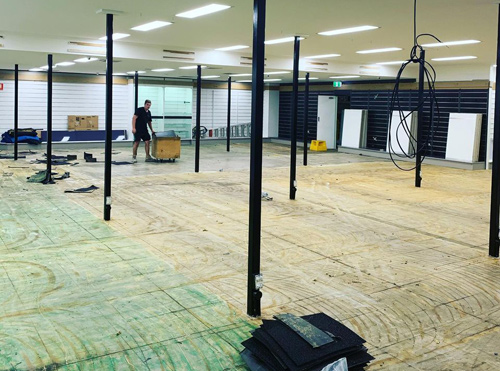Step-By-Step Tile Removal Process
Tile Removal with Diamond Grinding Equipment
In certain situations, tile removal may require the use of diamond grinding equipment.
This method offers several advantages and is particularly effective for removing stubborn tiles, glues/adhesives or for situations where traditional tile removal techniques may not be suitable.
Here's an overview of the tile removal process using diamond grinding equipment:
Evaluation and Preparation
Before starting the tile removal process with diamond grinding, a professional technician will evaluate the condition of your tiles, the underlying surface, and the scope of the project.
This evaluation helps determine the appropriate diamond grinding technique and equipment needed for the job. The tech will also take necessary precautions to protect adjacent surfaces and ensure a safe working environment.
Diamond Grinding Equipment
Diamond grinding utilizes powerful machines equipped with rotating diamond blades or discs.
These blades or discs feature industrial-grade diamonds embedded in their surface, which enable efficient and precise removal of tiles, adhesives, and other flooring materials.
The equipment may vary depending on the size and complexity of the project, ranging from handheld grinders for smaller areas to larger, ride-on machines for more extensive tile removal and floor removal projects.
Grinding Process
- Surface Preparation: The technician will prepare the area by removing any furniture, fixtures, or obstacles. They will also apply protective coverings to nearby surfaces to prevent any damage.
- Coarse Grinding: The initial grinding phase involves using coarse diamond blades or discs to break through the surface of the tiles. The technician will systematically move the grinding equipment across the floor, gradually removing the tiles and reducing them to smaller pieces.
- Fine Grinding: Once the tiles have been broken, the technician will switch to finer-grit diamond blades or discs to refine the surface and remove any remaining tile fragments, adhesive, or grout. This step ensures a smooth and clean surface for the subsequent flooring installation.
- Clean Up: After the grinding process, the technician will thoroughly clean the area, removing any debris or dust generated during the tile removal. They will dispose of the removed materials appropriately, leaving the space ready for the next phase of your project.
Benefits of Diamond Grinding
The use of diamond grinding equipment for tile removal offers several benefits:
- Efficiency: Diamond grinding is a highly efficient method that can expedite the tile removal process, saving both time and effort.
- Precision: The precise control and versatility of diamond grinding equipment allow technicians to target specific areas, ensuring thorough removal without damaging the underlying surface.
- Versatility: Diamond grinding can be used on various types of tiles, including ceramic, porcelain, stone, and even resilient flooring materials like vinyl or epoxy.
- Minimal Dust and Noise: The equipment used for diamond grinding is equipped with dust containment systems, minimizing dust and noise levels during the process.
- Smooth Surface Preparation: Diamond grinding leaves the underlying surface smooth and properly prepared for the installation of new flooring, eliminating the need for extensive additional surface preparation.
When considering tile removal, consult with a professional company experienced in diamond grinding techniques.
They can assess your specific needs, recommend the most suitable approach, and ensure a successful tile removal process that meets your expectations.
DIY Tile Removal Process
- Prepare the Area: Clear the room of any furniture or obstacles to create a safe and accessible work environment.
- Protect Adjacent Areas: Cover adjacent surfaces or objects with drop cloths or plastic sheets to prevent damage during the tile removal process.
- Start with a Test Area: Begin by selecting a small section of the floor to test your tile removal technique. This allows you to determine the best approach and estimate the effort required.
- Break the Tiles: Using a hammer, carefully strike the tiles in the test area to break them into smaller pieces. Aim for the centre of each tile to minimize the risk of damaging the underlying surface.
- Remove Broken Tiles: Use a chisel or pry bar to lift and remove the broken tile pieces. Work from the edges of the test area and gradually progress towards the centre.
- Repeat the Process: Once you've successfully removed the tiles from the test area, apply the same technique to the rest of the floor. Work in manageable sections to maintain control and avoid overwhelming yourself.
- Remove Adhesive and Grout: After all the tiles have been removed, use a floor scraper to eliminate any adhesive or grout residue. Take your time to ensure a clean and even surface for the next flooring installation.
- Clean the Floor: Finally, use a floor scrubber or a mop with a suitable cleaning solution to remove any remaining debris or dust. Allow the floor to dry completely before proceeding with the next steps of your floor stripping project.
By following these steps and utilizing the right tools, you can effectively remove tiles during the floor stripping process.
Remember to prioritise safety and take breaks as needed to avoid fatigue.

